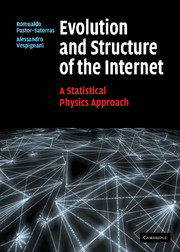Book contents
- Frontmatter
- Contents
- Preface
- List of abbreviations
- 1 A brief history of the Internet
- 2 How the Internet works
- 3 Measuring the global Internet
- 4 The Internet's large-scale topology
- 5 Modeling the Internet
- 6 Internet robustness
- 7 Virtual and social networks in the Internet
- 8 Searching and walking on the Internet
- 9 Epidemics in the Internet
- 10 Beyond the Internet's skeleton: traffic and global performance
- 11 Outlook
- Appendix 1 Graph theory applied to topology analysis
- Appendix 2 Interface resolution and router topology
- Appendix 3 Numerical analysis of heavy tailed distributions
- Appendix 4 Degree correlations
- Appendix 5 Scale-free networks: scaling relations
- Appendix 6 The SIR model of virus propagation
- References
- Index
8 - Searching and walking on the Internet
Published online by Cambridge University Press: 12 January 2010
- Frontmatter
- Contents
- Preface
- List of abbreviations
- 1 A brief history of the Internet
- 2 How the Internet works
- 3 Measuring the global Internet
- 4 The Internet's large-scale topology
- 5 Modeling the Internet
- 6 Internet robustness
- 7 Virtual and social networks in the Internet
- 8 Searching and walking on the Internet
- 9 Epidemics in the Internet
- 10 Beyond the Internet's skeleton: traffic and global performance
- 11 Outlook
- Appendix 1 Graph theory applied to topology analysis
- Appendix 2 Interface resolution and router topology
- Appendix 3 Numerical analysis of heavy tailed distributions
- Appendix 4 Degree correlations
- Appendix 5 Scale-free networks: scaling relations
- Appendix 6 The SIR model of virus propagation
- References
- Index
Summary
The problem of searching in complex networks is a very relevant issue, with a large number of practical applications. As the most obvious example of this problem we can consider the World Wide Web. It is an immense data depot that, however, acquires a practical interest and value only if it is possible to locate the particular information one is looking for. Probably, the first instance in which searching in complex networks has been considered is in the sociological context. In a now famous experiment, Milgram (1967) randomly selected people in a town in the Midwest, and asked them to send a letter to a target person living in Boston. The rule was that letters could not be sent directly but passed from person to person, only between people known on a first-name basis, until reaching the target. The unexpected result of this experiment was that the letters that arrived to the target traveled through short chains of acquaintances, with an average length of only six intermediate hops. The conclusion that can be drawn from this result is not only that short paths exist between the vertices of a social network (the small-world property), but that these paths can be efficiently found in order to transmit information. The very same scenario turns out to be very relevant also for technological networks such as the Internet.
In this chapter we will review the main searching strategies that can be applied in order to retrieve information from the vertices of a network, focusing specially on the Internet and the virtual networks hosted by it.
- Type
- Chapter
- Information
- Evolution and Structure of the InternetA Statistical Physics Approach, pp. 166 - 179Publisher: Cambridge University PressPrint publication year: 2004



